ECHL213 Essay: Examining Negative Images of Childhood Obesity
VerifiedAdded on 2022/08/24
|6
|1822
|8
Essay
AI Summary
This essay examines the negative images associated with childhood obesity, a significant public health concern, particularly in Western countries. It argues that negative perceptions, or weight stigma, are prevalent across various societal elements including parents, peers, the media, and healthcare professionals. The essay details how parental views, often influenced by societal pressures for thinness, can contribute to children's weight concerns and potential for dieting disorders. It further explores how peers may stigmatize obese children, leading to social isolation and academic difficulties. Additionally, the essay discusses the media's role in perpetuating negative stereotypes and biases, highlighting instances of derogatory advertisements and bullying. Finally, it concludes that negative images, stemming from cultural biases and societal expectations, can negatively impact obese children's psychological well-being, healthcare experiences, and overall development. The essay uses current evidence from various research studies to support its arguments.

IMAGES OF OBESITY IN CHILDHOOD
Paraphrase This Document
Need a fresh take? Get an instant paraphrase of this document with our AI Paraphraser
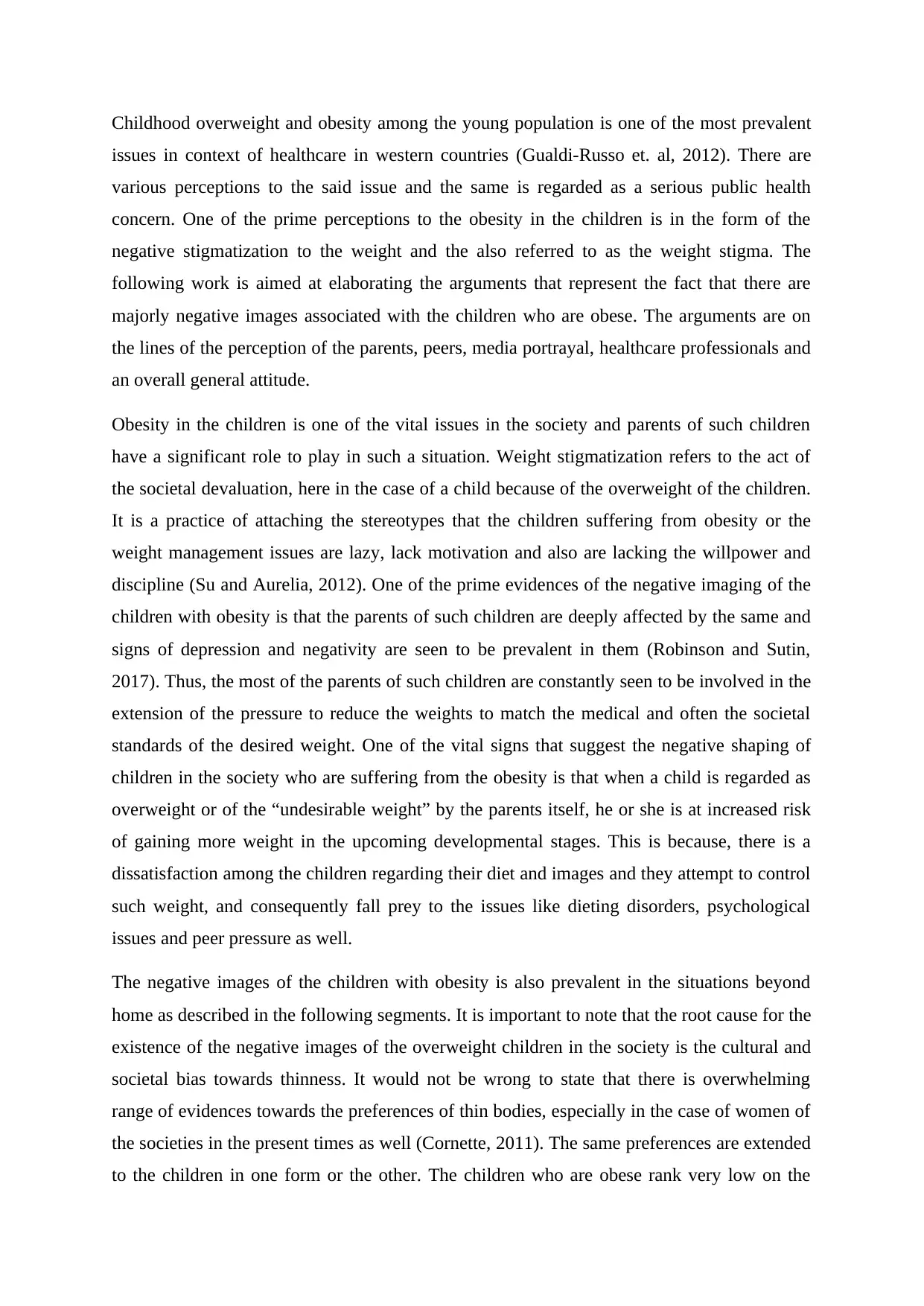
Childhood overweight and obesity among the young population is one of the most prevalent
issues in context of healthcare in western countries (Gualdi-Russo et. al, 2012). There are
various perceptions to the said issue and the same is regarded as a serious public health
concern. One of the prime perceptions to the obesity in the children is in the form of the
negative stigmatization to the weight and the also referred to as the weight stigma. The
following work is aimed at elaborating the arguments that represent the fact that there are
majorly negative images associated with the children who are obese. The arguments are on
the lines of the perception of the parents, peers, media portrayal, healthcare professionals and
an overall general attitude.
Obesity in the children is one of the vital issues in the society and parents of such children
have a significant role to play in such a situation. Weight stigmatization refers to the act of
the societal devaluation, here in the case of a child because of the overweight of the children.
It is a practice of attaching the stereotypes that the children suffering from obesity or the
weight management issues are lazy, lack motivation and also are lacking the willpower and
discipline (Su and Aurelia, 2012). One of the prime evidences of the negative imaging of the
children with obesity is that the parents of such children are deeply affected by the same and
signs of depression and negativity are seen to be prevalent in them (Robinson and Sutin,
2017). Thus, the most of the parents of such children are constantly seen to be involved in the
extension of the pressure to reduce the weights to match the medical and often the societal
standards of the desired weight. One of the vital signs that suggest the negative shaping of
children in the society who are suffering from the obesity is that when a child is regarded as
overweight or of the “undesirable weight” by the parents itself, he or she is at increased risk
of gaining more weight in the upcoming developmental stages. This is because, there is a
dissatisfaction among the children regarding their diet and images and they attempt to control
such weight, and consequently fall prey to the issues like dieting disorders, psychological
issues and peer pressure as well.
The negative images of the children with obesity is also prevalent in the situations beyond
home as described in the following segments. It is important to note that the root cause for the
existence of the negative images of the overweight children in the society is the cultural and
societal bias towards thinness. It would not be wrong to state that there is overwhelming
range of evidences towards the preferences of thin bodies, especially in the case of women of
the societies in the present times as well (Cornette, 2011). The same preferences are extended
to the children in one form or the other. The children who are obese rank very low on the
issues in context of healthcare in western countries (Gualdi-Russo et. al, 2012). There are
various perceptions to the said issue and the same is regarded as a serious public health
concern. One of the prime perceptions to the obesity in the children is in the form of the
negative stigmatization to the weight and the also referred to as the weight stigma. The
following work is aimed at elaborating the arguments that represent the fact that there are
majorly negative images associated with the children who are obese. The arguments are on
the lines of the perception of the parents, peers, media portrayal, healthcare professionals and
an overall general attitude.
Obesity in the children is one of the vital issues in the society and parents of such children
have a significant role to play in such a situation. Weight stigmatization refers to the act of
the societal devaluation, here in the case of a child because of the overweight of the children.
It is a practice of attaching the stereotypes that the children suffering from obesity or the
weight management issues are lazy, lack motivation and also are lacking the willpower and
discipline (Su and Aurelia, 2012). One of the prime evidences of the negative imaging of the
children with obesity is that the parents of such children are deeply affected by the same and
signs of depression and negativity are seen to be prevalent in them (Robinson and Sutin,
2017). Thus, the most of the parents of such children are constantly seen to be involved in the
extension of the pressure to reduce the weights to match the medical and often the societal
standards of the desired weight. One of the vital signs that suggest the negative shaping of
children in the society who are suffering from the obesity is that when a child is regarded as
overweight or of the “undesirable weight” by the parents itself, he or she is at increased risk
of gaining more weight in the upcoming developmental stages. This is because, there is a
dissatisfaction among the children regarding their diet and images and they attempt to control
such weight, and consequently fall prey to the issues like dieting disorders, psychological
issues and peer pressure as well.
The negative images of the children with obesity is also prevalent in the situations beyond
home as described in the following segments. It is important to note that the root cause for the
existence of the negative images of the overweight children in the society is the cultural and
societal bias towards thinness. It would not be wrong to state that there is overwhelming
range of evidences towards the preferences of thin bodies, especially in the case of women of
the societies in the present times as well (Cornette, 2011). The same preferences are extended
to the children in one form or the other. The children who are obese rank very low on the
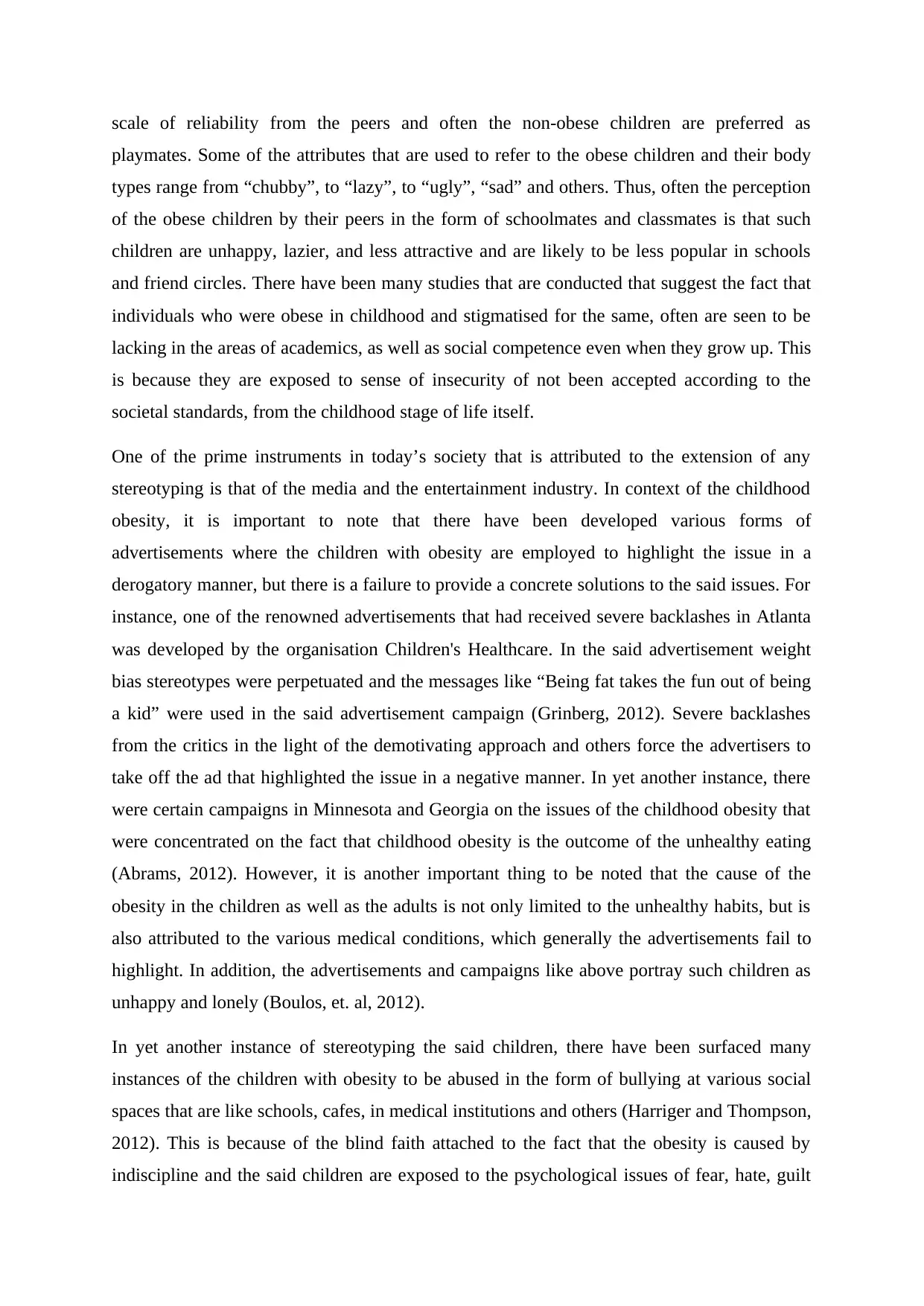
scale of reliability from the peers and often the non-obese children are preferred as
playmates. Some of the attributes that are used to refer to the obese children and their body
types range from “chubby”, to “lazy”, to “ugly”, “sad” and others. Thus, often the perception
of the obese children by their peers in the form of schoolmates and classmates is that such
children are unhappy, lazier, and less attractive and are likely to be less popular in schools
and friend circles. There have been many studies that are conducted that suggest the fact that
individuals who were obese in childhood and stigmatised for the same, often are seen to be
lacking in the areas of academics, as well as social competence even when they grow up. This
is because they are exposed to sense of insecurity of not been accepted according to the
societal standards, from the childhood stage of life itself.
One of the prime instruments in today’s society that is attributed to the extension of any
stereotyping is that of the media and the entertainment industry. In context of the childhood
obesity, it is important to note that there have been developed various forms of
advertisements where the children with obesity are employed to highlight the issue in a
derogatory manner, but there is a failure to provide a concrete solutions to the said issues. For
instance, one of the renowned advertisements that had received severe backlashes in Atlanta
was developed by the organisation Children's Healthcare. In the said advertisement weight
bias stereotypes were perpetuated and the messages like “Being fat takes the fun out of being
a kid” were used in the said advertisement campaign (Grinberg, 2012). Severe backlashes
from the critics in the light of the demotivating approach and others force the advertisers to
take off the ad that highlighted the issue in a negative manner. In yet another instance, there
were certain campaigns in Minnesota and Georgia on the issues of the childhood obesity that
were concentrated on the fact that childhood obesity is the outcome of the unhealthy eating
(Abrams, 2012). However, it is another important thing to be noted that the cause of the
obesity in the children as well as the adults is not only limited to the unhealthy habits, but is
also attributed to the various medical conditions, which generally the advertisements fail to
highlight. In addition, the advertisements and campaigns like above portray such children as
unhappy and lonely (Boulos, et. al, 2012).
In yet another instance of stereotyping the said children, there have been surfaced many
instances of the children with obesity to be abused in the form of bullying at various social
spaces that are like schools, cafes, in medical institutions and others (Harriger and Thompson,
2012). This is because of the blind faith attached to the fact that the obesity is caused by
indiscipline and the said children are exposed to the psychological issues of fear, hate, guilt
playmates. Some of the attributes that are used to refer to the obese children and their body
types range from “chubby”, to “lazy”, to “ugly”, “sad” and others. Thus, often the perception
of the obese children by their peers in the form of schoolmates and classmates is that such
children are unhappy, lazier, and less attractive and are likely to be less popular in schools
and friend circles. There have been many studies that are conducted that suggest the fact that
individuals who were obese in childhood and stigmatised for the same, often are seen to be
lacking in the areas of academics, as well as social competence even when they grow up. This
is because they are exposed to sense of insecurity of not been accepted according to the
societal standards, from the childhood stage of life itself.
One of the prime instruments in today’s society that is attributed to the extension of any
stereotyping is that of the media and the entertainment industry. In context of the childhood
obesity, it is important to note that there have been developed various forms of
advertisements where the children with obesity are employed to highlight the issue in a
derogatory manner, but there is a failure to provide a concrete solutions to the said issues. For
instance, one of the renowned advertisements that had received severe backlashes in Atlanta
was developed by the organisation Children's Healthcare. In the said advertisement weight
bias stereotypes were perpetuated and the messages like “Being fat takes the fun out of being
a kid” were used in the said advertisement campaign (Grinberg, 2012). Severe backlashes
from the critics in the light of the demotivating approach and others force the advertisers to
take off the ad that highlighted the issue in a negative manner. In yet another instance, there
were certain campaigns in Minnesota and Georgia on the issues of the childhood obesity that
were concentrated on the fact that childhood obesity is the outcome of the unhealthy eating
(Abrams, 2012). However, it is another important thing to be noted that the cause of the
obesity in the children as well as the adults is not only limited to the unhealthy habits, but is
also attributed to the various medical conditions, which generally the advertisements fail to
highlight. In addition, the advertisements and campaigns like above portray such children as
unhappy and lonely (Boulos, et. al, 2012).
In yet another instance of stereotyping the said children, there have been surfaced many
instances of the children with obesity to be abused in the form of bullying at various social
spaces that are like schools, cafes, in medical institutions and others (Harriger and Thompson,
2012). This is because of the blind faith attached to the fact that the obesity is caused by
indiscipline and the said children are exposed to the psychological issues of fear, hate, guilt
⊘ This is a preview!⊘
Do you want full access?
Subscribe today to unlock all pages.

Trusted by 1+ million students worldwide
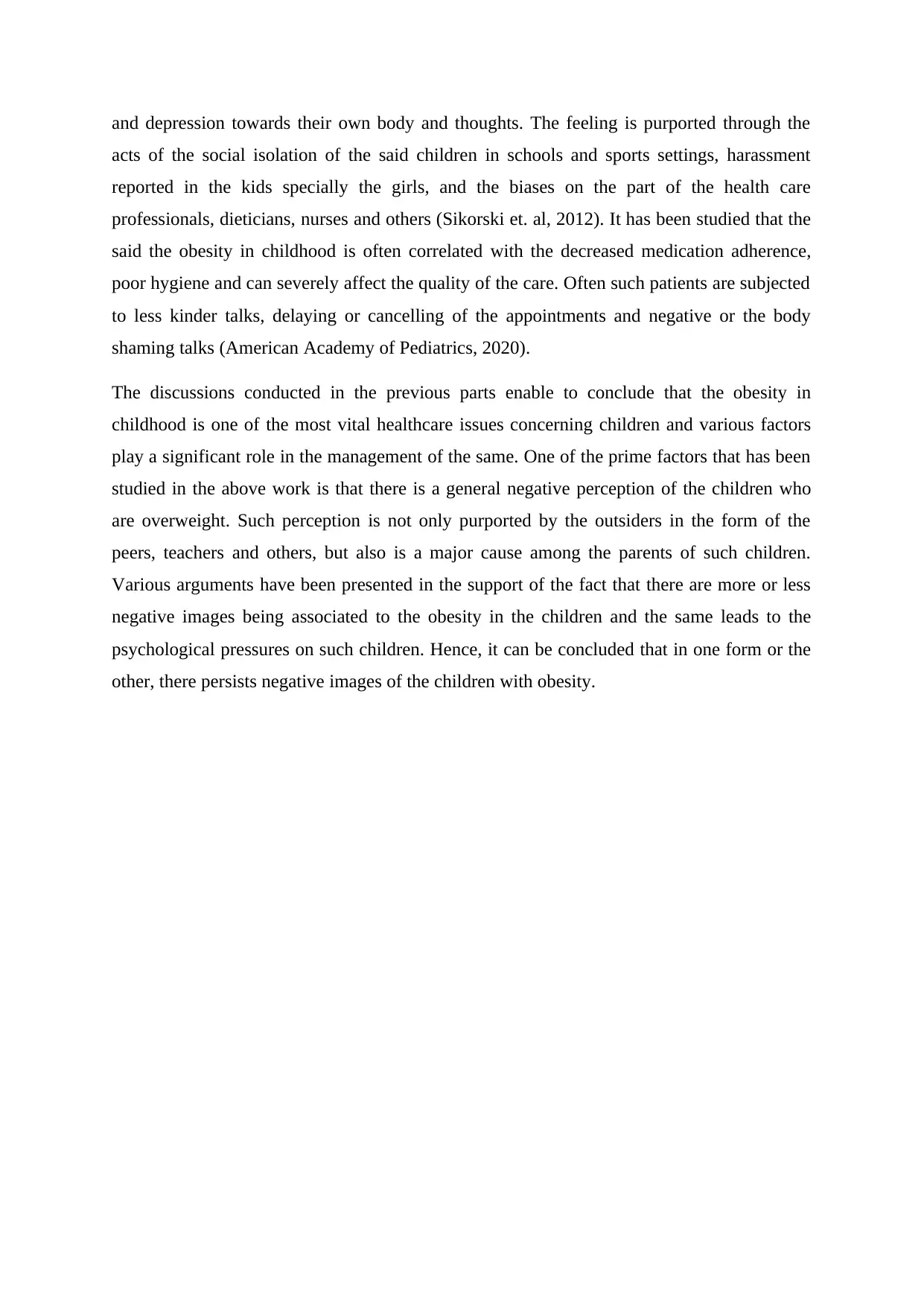
and depression towards their own body and thoughts. The feeling is purported through the
acts of the social isolation of the said children in schools and sports settings, harassment
reported in the kids specially the girls, and the biases on the part of the health care
professionals, dieticians, nurses and others (Sikorski et. al, 2012). It has been studied that the
said the obesity in childhood is often correlated with the decreased medication adherence,
poor hygiene and can severely affect the quality of the care. Often such patients are subjected
to less kinder talks, delaying or cancelling of the appointments and negative or the body
shaming talks (American Academy of Pediatrics, 2020).
The discussions conducted in the previous parts enable to conclude that the obesity in
childhood is one of the most vital healthcare issues concerning children and various factors
play a significant role in the management of the same. One of the prime factors that has been
studied in the above work is that there is a general negative perception of the children who
are overweight. Such perception is not only purported by the outsiders in the form of the
peers, teachers and others, but also is a major cause among the parents of such children.
Various arguments have been presented in the support of the fact that there are more or less
negative images being associated to the obesity in the children and the same leads to the
psychological pressures on such children. Hence, it can be concluded that in one form or the
other, there persists negative images of the children with obesity.
acts of the social isolation of the said children in schools and sports settings, harassment
reported in the kids specially the girls, and the biases on the part of the health care
professionals, dieticians, nurses and others (Sikorski et. al, 2012). It has been studied that the
said the obesity in childhood is often correlated with the decreased medication adherence,
poor hygiene and can severely affect the quality of the care. Often such patients are subjected
to less kinder talks, delaying or cancelling of the appointments and negative or the body
shaming talks (American Academy of Pediatrics, 2020).
The discussions conducted in the previous parts enable to conclude that the obesity in
childhood is one of the most vital healthcare issues concerning children and various factors
play a significant role in the management of the same. One of the prime factors that has been
studied in the above work is that there is a general negative perception of the children who
are overweight. Such perception is not only purported by the outsiders in the form of the
peers, teachers and others, but also is a major cause among the parents of such children.
Various arguments have been presented in the support of the fact that there are more or less
negative images being associated to the obesity in the children and the same leads to the
psychological pressures on such children. Hence, it can be concluded that in one form or the
other, there persists negative images of the children with obesity.
Paraphrase This Document
Need a fresh take? Get an instant paraphrase of this document with our AI Paraphraser
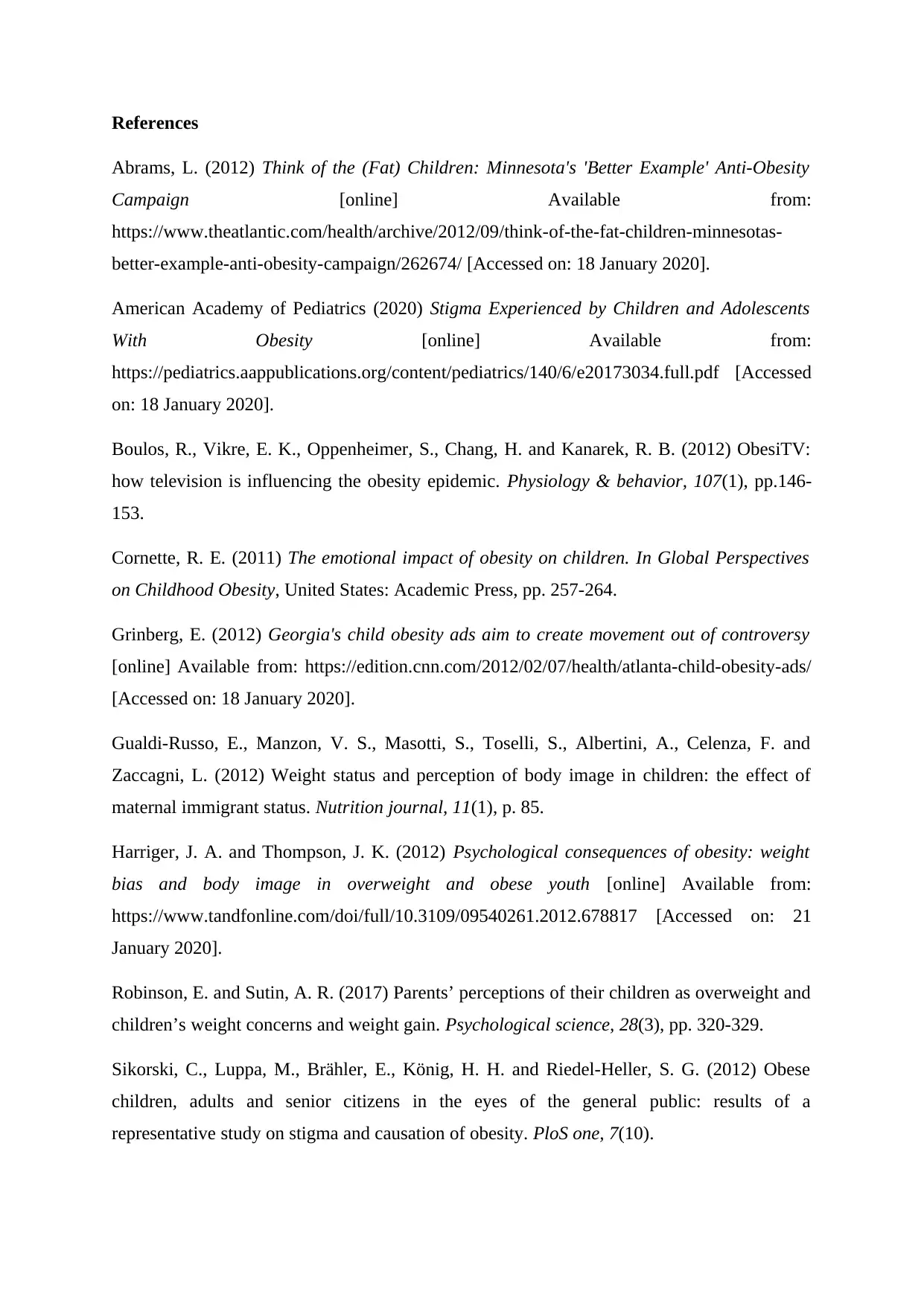
References
Abrams, L. (2012) Think of the (Fat) Children: Minnesota's 'Better Example' Anti-Obesity
Campaign [online] Available from:
https://www.theatlantic.com/health/archive/2012/09/think-of-the-fat-children-minnesotas-
better-example-anti-obesity-campaign/262674/ [Accessed on: 18 January 2020].
American Academy of Pediatrics (2020) Stigma Experienced by Children and Adolescents
With Obesity [online] Available from:
https://pediatrics.aappublications.org/content/pediatrics/140/6/e20173034.full.pdf [Accessed
on: 18 January 2020].
Boulos, R., Vikre, E. K., Oppenheimer, S., Chang, H. and Kanarek, R. B. (2012) ObesiTV:
how television is influencing the obesity epidemic. Physiology & behavior, 107(1), pp.146-
153.
Cornette, R. E. (2011) The emotional impact of obesity on children. In Global Perspectives
on Childhood Obesity, United States: Academic Press, pp. 257-264.
Grinberg, E. (2012) Georgia's child obesity ads aim to create movement out of controversy
[online] Available from: https://edition.cnn.com/2012/02/07/health/atlanta-child-obesity-ads/
[Accessed on: 18 January 2020].
Gualdi-Russo, E., Manzon, V. S., Masotti, S., Toselli, S., Albertini, A., Celenza, F. and
Zaccagni, L. (2012) Weight status and perception of body image in children: the effect of
maternal immigrant status. Nutrition journal, 11(1), p. 85.
Harriger, J. A. and Thompson, J. K. (2012) Psychological consequences of obesity: weight
bias and body image in overweight and obese youth [online] Available from:
https://www.tandfonline.com/doi/full/10.3109/09540261.2012.678817 [Accessed on: 21
January 2020].
Robinson, E. and Sutin, A. R. (2017) Parents’ perceptions of their children as overweight and
children’s weight concerns and weight gain. Psychological science, 28(3), pp. 320-329.
Sikorski, C., Luppa, M., Brähler, E., König, H. H. and Riedel-Heller, S. G. (2012) Obese
children, adults and senior citizens in the eyes of the general public: results of a
representative study on stigma and causation of obesity. PloS one, 7(10).
Abrams, L. (2012) Think of the (Fat) Children: Minnesota's 'Better Example' Anti-Obesity
Campaign [online] Available from:
https://www.theatlantic.com/health/archive/2012/09/think-of-the-fat-children-minnesotas-
better-example-anti-obesity-campaign/262674/ [Accessed on: 18 January 2020].
American Academy of Pediatrics (2020) Stigma Experienced by Children and Adolescents
With Obesity [online] Available from:
https://pediatrics.aappublications.org/content/pediatrics/140/6/e20173034.full.pdf [Accessed
on: 18 January 2020].
Boulos, R., Vikre, E. K., Oppenheimer, S., Chang, H. and Kanarek, R. B. (2012) ObesiTV:
how television is influencing the obesity epidemic. Physiology & behavior, 107(1), pp.146-
153.
Cornette, R. E. (2011) The emotional impact of obesity on children. In Global Perspectives
on Childhood Obesity, United States: Academic Press, pp. 257-264.
Grinberg, E. (2012) Georgia's child obesity ads aim to create movement out of controversy
[online] Available from: https://edition.cnn.com/2012/02/07/health/atlanta-child-obesity-ads/
[Accessed on: 18 January 2020].
Gualdi-Russo, E., Manzon, V. S., Masotti, S., Toselli, S., Albertini, A., Celenza, F. and
Zaccagni, L. (2012) Weight status and perception of body image in children: the effect of
maternal immigrant status. Nutrition journal, 11(1), p. 85.
Harriger, J. A. and Thompson, J. K. (2012) Psychological consequences of obesity: weight
bias and body image in overweight and obese youth [online] Available from:
https://www.tandfonline.com/doi/full/10.3109/09540261.2012.678817 [Accessed on: 21
January 2020].
Robinson, E. and Sutin, A. R. (2017) Parents’ perceptions of their children as overweight and
children’s weight concerns and weight gain. Psychological science, 28(3), pp. 320-329.
Sikorski, C., Luppa, M., Brähler, E., König, H. H. and Riedel-Heller, S. G. (2012) Obese
children, adults and senior citizens in the eyes of the general public: results of a
representative study on stigma and causation of obesity. PloS one, 7(10).
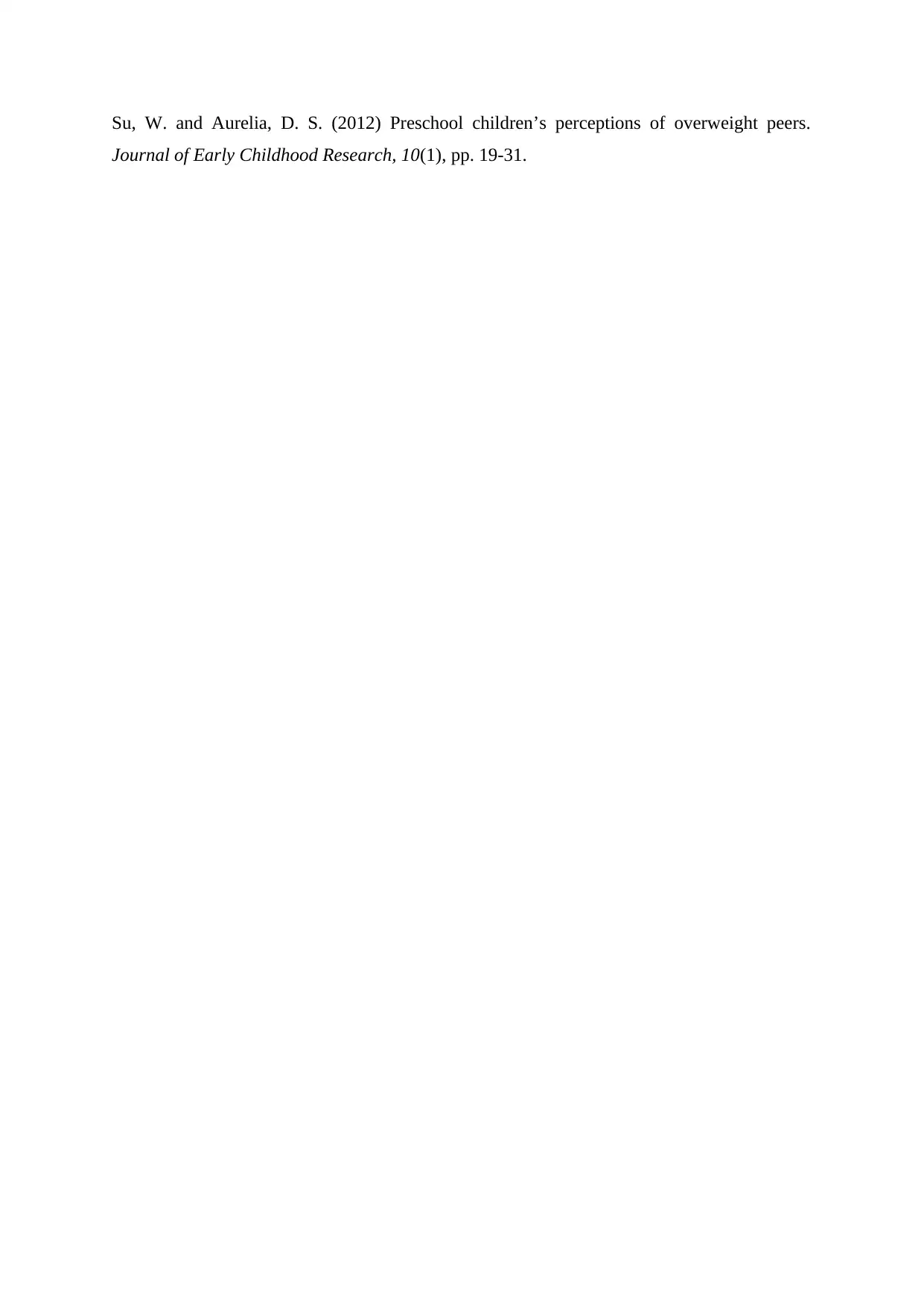
Su, W. and Aurelia, D. S. (2012) Preschool children’s perceptions of overweight peers.
Journal of Early Childhood Research, 10(1), pp. 19-31.
Journal of Early Childhood Research, 10(1), pp. 19-31.
⊘ This is a preview!⊘
Do you want full access?
Subscribe today to unlock all pages.

Trusted by 1+ million students worldwide
1 out of 6
Related Documents
Your All-in-One AI-Powered Toolkit for Academic Success.
+13062052269
info@desklib.com
Available 24*7 on WhatsApp / Email
![[object Object]](/_next/static/media/star-bottom.7253800d.svg)
Unlock your academic potential
Copyright © 2020–2025 A2Z Services. All Rights Reserved. Developed and managed by ZUCOL.





